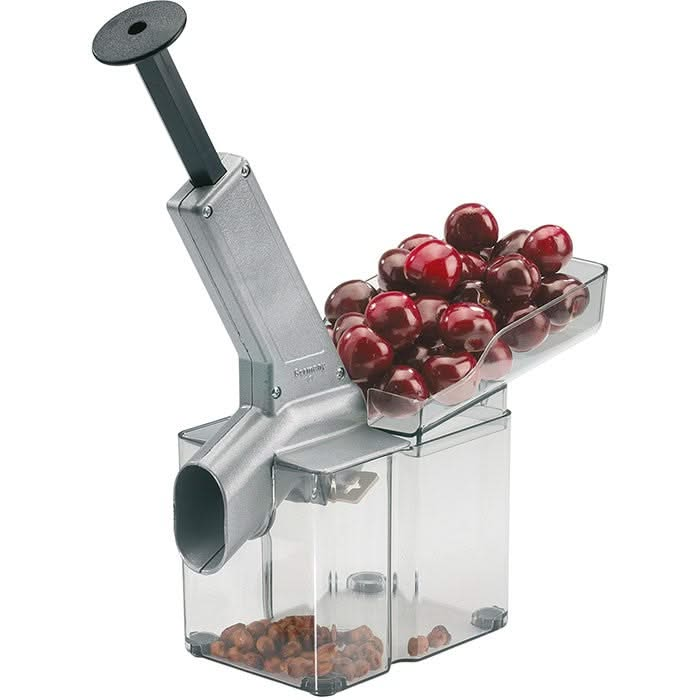Imagine biting into a juicy cherry, only to have your enjoyment interrupted by a stubborn pit. If you’ve ever found yourself in this predicament, you know how frustrating it can be.
That’s why cherry pitters are essential tools for any fruit lover. But when it comes to choosing the right cherry pitter, you might find yourself torn between manual and automatic options. Which one will save you time? Which one will give you perfectly pitted cherries every time?
And most importantly, which one is worth your investment? We’re diving into the world of cherry pitters, comparing manual and automatic models to help you make the best choice for your kitchen. You’ll discover the pros and cons of each type, learn about the features that truly matter, and find out how to enhance your cherry-pitting experience. Whether you’re preparing for a summer pie extravaganza or just want hassle-free snacking, this guide will lead you to the perfect cherry pitter for your needs. Keep reading to unlock the secrets of cherry pitting mastery!
Manual Cherry Pitters
If you enjoy making cherry pies or simply snacking on fresh cherries, you’ve likely faced the challenge of removing pits. Manual cherry pitters offer a hands-on approach to this task. They allow you to connect with the process and savor each step of preparing cherries for your favorite recipes. But what makes manual cherry pitters so appealing? Let’s dive into their design, functionality, and consider if they’re the right fit for your kitchen.
Design And Functionality
Manual cherry pitters are typically compact and easy to handle. They often resemble simple handheld tools, sometimes with a plunger or lever mechanism. Picture holding one in your hand, giving you control over the pressure and direction while extracting pits. This design minimizes the risk of damaging the fruit, preserving its juicy goodness. The straightforward mechanism means you can easily clean and store them when not in use.
Think about a time when you wanted to pit cherries without hassle. A manual pitter allows you to work at your own pace, feeling the satisfaction of each pit popping out effortlessly. The simplicity in their design ensures you spend less time figuring out how to use them and more time enjoying the cherries themselves.
Pros And Cons
Every tool has its strengths and weaknesses. Manual cherry pitters offer precision and control, making them ideal for small batches. They’re usually budget-friendly, saving you money compared to automatic options. Plus, they don’t require electricity, so you can use them anywhere.
On the downside, manual pitters can be slower, especially if you have a large number of cherries. They require more physical effort, which might not be ideal if you plan to pit cherries frequently. Additionally, they may not be suitable for people with limited hand strength or dexterity.
Ideal User Scenarios
Do you enjoy taking a mindful approach to cooking? Manual cherry pitters are perfect for those who appreciate the tactile experience of preparing food. They’re great for small batches, like when making a quick cherry topping for ice cream or a modest cherry salad.
If you’re someone who likes to pack light for picnics or camping trips, a manual pitter can be a handy addition to your gear. They require no power source, so you can easily pit cherries while enjoying the great outdoors. Consider how they might fit into your lifestyle or kitchen routine.
Manual cherry pitters offer a unique, hands-on experience. Are they the right tool for your culinary adventures? Your choice depends on the balance between effort and enjoyment you seek in your kitchen tasks.

Credit: www.amazon.com
Automatic Cherry Pitters
Manual cherry pitters require hand effort and time, while automatic ones save energy and work faster. Each type serves different needs, making them suitable for various users in kitchen tasks.
Automatic cherry pitters streamline the process of removing pits from cherries. These devices save time and effort, making them popular in busy kitchens. Automatic pitters handle large quantities of cherries quickly. They are ideal for those who process cherries in bulk.Mechanism And Features
Automatic cherry pitters use a motorized system to extract pits. The cherries are placed in a hopper. They move through a series of rotating blades or punches. The pits are pushed out, leaving the cherry intact. Some models offer adjustable settings for different cherry sizes. Many include a collection tray for pits, keeping the workspace clean.Advantages And Disadvantages
Automatic pitters handle large volumes of cherries efficiently. They save time, especially in commercial settings. The motorized operation requires less manual effort. These devices can be bulky, taking up kitchen space. They often have a higher price tag than manual versions. Some users find them harder to clean due to complex parts.Suitable Usage Cases
Automatic cherry pitters are perfect for bakeries and restaurants. They suit home users who frequently prepare cherry dishes. Ideal for making cherry pies, jams, or preserves. They benefit those who harvest cherries in large quantities.Performance Comparison
Manual cherry pitters offer control and precision but can be time-consuming. Automatic pitters are faster, handling larger batches efficiently. Both have their pros and cons, depending on the user’s needs and preferences.
When you’re on a mission to pit cherries, the choice between manual and automatic pitters often boils down to performance. How quickly and accurately each tool removes the pit can make a big difference in your kitchen workflow. Let’s dive into comparing these two types of cherry pitters and see how they stack up against each other.Speed And Efficiency
Manual cherry pitters require a bit of elbow grease. You might find yourself spending more time if you’re dealing with a large batch. However, they offer a hands-on experience that some people enjoy. Automatic cherry pitters, on the other hand, can handle a large number of cherries in a short amount of time. They are designed to pit cherries faster, saving you valuable time, especially during peak cherry season. Consider your needs. Do you need to pit a lot of cherries quickly? Or do you enjoy a slower pace with more control?Consistency And Precision
Manual pitters can sometimes result in varied outcomes. You might end up with a few cherries that are not perfectly pitted, which can be frustrating if you’re aiming for perfection. However, with practice, you can improve your technique. Automatic cherry pitters are generally more consistent. They are engineered to produce uniform results, ensuring each cherry is pitted precisely. This can be especially important if you are preparing cherries for a specific recipe or presentation. Think about your priorities. Is precision essential for your cherry-related endeavors? Or are you okay with a bit of variability for the sake of a hands-on experience? In the end, both types of cherry pitters have their merits. The best choice depends on what you value more—speed and consistency or control and experience. What matters most to you when preparing cherries?
Credit: www.amazon.com
Cost Analysis
Deciding between manual and automatic cherry pitters involves comparing costs and efficiency. Manual pitters are cheaper but require more time. Automatic pitters cost more upfront, yet save time and effort. Each option offers distinct benefits depending on budget and usage needs.
When deciding between a manual and an automatic cherry pitter, cost can play a significant role in your decision-making process. Understanding the initial price and long-term investment of each option helps you make an informed choice that suits your needs and budget. Let’s dive into the cost analysis of these two cherry pitter types.Price Range
Manual cherry pitters are generally more affordable than their automatic counterparts. You can find them priced as low as $10 to $20, which makes them accessible for most budgets. They are perfect if you just want a simple tool for occasional use. Automatic cherry pitters, on the other hand, come with a higher price tag, often ranging from $30 to $60 or more. This higher cost reflects their enhanced efficiency and convenience, especially if you need to process large batches of cherries regularly.Long-term Investment
A manual cherry pitter might seem like a bargain initially, but is it the best long-term choice? If you frequently bake or preserve cherries, this tool could end up being labor-intensive. Consider the time and effort spent pitting cherries manually. Automatic cherry pitters, while more expensive upfront, save time and energy in the long run. They can pit cherries much faster, making them an excellent investment for avid cherry enthusiasts. Their sturdy construction often means a longer lifespan, reducing the need for frequent replacements. Have you considered how often you use a cherry pitter? If your cherry consumption is seasonal, a manual pitter might suffice. However, for regular use, investing in an automatic option could provide better value over time. When choosing between manual and automatic, think about your typical cherry usage and budget. Would you prefer a lower initial cost with more manual effort, or are you willing to invest a bit more for convenience and efficiency?Maintenance And Durability
Maintaining a cherry pitter is crucial for its efficiency and lifespan. Manual and automatic cherry pitters have different maintenance needs. Understanding these needs helps in choosing the right one. Let’s explore how ease of cleaning and durability play a role.
Ease Of Cleaning
Manual cherry pitters are simple in design. Cleaning them is often straightforward. Most parts are easy to reach. You can rinse them under water or wipe with a damp cloth. Their lack of complex parts makes them less prone to residue build-up.
Automatic pitters often have more parts. This can make cleaning more involved. You may need to disassemble some parts. Regular cleaning prevents clogging and ensures smooth operation. Follow manufacturer instructions for best results.
Longevity And Wear
Manual pitters often last longer. They have fewer moving parts. Less wear and tear occurs over time. They are usually made of sturdy materials like stainless steel. This adds to their durability.
Automatic pitters may experience more wear. Moving parts can break down faster. Regular maintenance is key to extending their lifespan. High-quality models may offer better durability. Consider the materials used in construction.
:max_bytes(150000):strip_icc()/Web_1500-SES-Best-cherry-pitters-group-0919-Carrie-Honaker-43ad4b0a3e84446bbf23b8af21280a02.jpg)
Credit: www.thespruceeats.com
User Experience
When you’re choosing between manual and automatic cherry pitters, user experience is key. Imagine preparing cherries for a summer dessert. You want a tool that makes the job easy and comfortable. Let’s explore how these devices stack up in terms of ease of use and comfort.
Ease Of Use
Have you ever tried to pit cherries with a manual pitter? It can feel like a workout session. You need to squeeze the handles and align the cherry just right. It requires a bit of patience and skill. Yet, there’s a certain satisfaction in mastering it.
On the other hand, automatic pitters offer convenience at the press of a button. They make the task quick and effortless. You can pit a bowl of cherries in minutes. But is speed always the best choice for you?
Comfort And Ergonomics
Comfort is crucial when you’re handling kitchen tools. Manual pitters often have ergonomic designs. They fit nicely in your hand, reducing strain. You might appreciate their simplicity and control.
Automatic pitters, however, excel in reducing repetitive motion. They are ideal if you have a large batch to process. Their design minimizes effort, but sometimes they can be bulky. Have you considered how much counter space you’re willing to spare?
Choosing between manual and automatic is more than just ease and speed. It’s about what feels right for your kitchen routine. Which tool would transform your cherry-pitting experience? The decision is in your hands.
Environmental Impact
Choosing between manual and automatic cherry pitters has environmental implications. Each type impacts the planet differently. Understanding these differences helps make eco-friendly choices.
Material And Manufacturing
Manual cherry pitters often use materials like stainless steel or wood. These materials are durable and require less energy in production. Automatic pitters usually need plastic and electronic components. Manufacturing these involves complex processes that increase resource use.
Plastic components add environmental challenges. They often contribute to waste. Wood or steel pitters can be recycled more easily, reducing environmental footprint.
Energy Consumption
Manual pitters don’t need electricity. They rely on human energy, which is sustainable. Automatic pitters need power, increasing energy use. This reliance on electricity impacts the environment. It contributes to carbon emissions.
Energy-efficient models can reduce impact. Yet, manual options remain the eco-friendlier choice. They minimize energy consumption and environmental strain.
Choosing The Right Pitter
Choosing the right cherry pitter can make a big difference in your kitchen. Whether you bake often or enjoy fresh cherries, a pitter is handy. There are manual and automatic options, each with its own benefits. Understanding your needs and exploring market options helps decide.
Personal Needs Assessment
Think about how often you use a cherry pitter. If you pit cherries daily, a reliable model is essential. Consider how much space you have in your kitchen. Manual pitters are small and fit easily in drawers. Automatic pitters are larger but save time if you have a busy schedule. Also, consider your budget. Manual pitters are usually cheaper. Automatic pitters might cost more but offer convenience.
Market Options
Explore different brands and models available. Manual pitters come in various designs. Some are simple handheld tools. Others have trays to catch pits. Automatic pitters have features like adjustable settings. Some models can pit different fruit sizes. Read reviews and check ratings for quality assurance. Look for durable materials. Stainless steel models last longer. Plastic models are lightweight but may break easily.
Frequently Asked Questions
How To Depit Cherries Without A Pitter?
Use a straw or chopstick to push out the cherry pit. Insert it at the stem hole. Twist gently to remove the pit.
Can You Use A Cherry Pitter To Pit Olives?
Yes, a cherry pitter can be used to pit olives. Ensure the pitter fits the olive size properly. This tool helps easily remove pits, making it a convenient choice for small tasks in the kitchen. Remember, it’s most effective for smaller olives.
How To Pit Cherries In Bulk?
Use a cherry pitter or reusable straw for efficient bulk pitting. Place cherries on a cutting board. Push the pitter or straw through the stem end. Catch pits with a bowl. Repeat the process for all cherries. This method speeds up the process and minimizes mess.
How Do You Use Progressive Cherry Pitter?
Place the cherry in the pitter cup. Press the lever firmly to remove the pit. Repeat for more cherries.
Conclusion
Choosing between manual and automatic cherry pitters depends on your needs. Manual pitters are simple and cost-effective. They suit small tasks well. Automatic pitters save time and effort. Ideal for large batches. Both types have pros and cons. Consider your kitchen space and budget.
Think about how often you pit cherries. Frequent users might prefer automatic models. Occasional users might find manual ones sufficient. Each has its place in the kitchen. Make a choice that fits your lifestyle. Happy cherry pitting!


